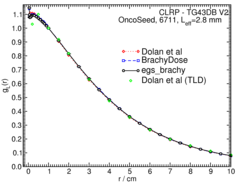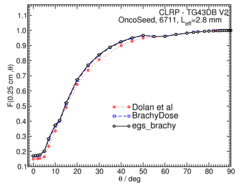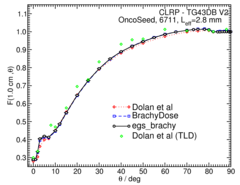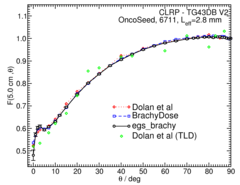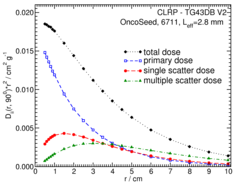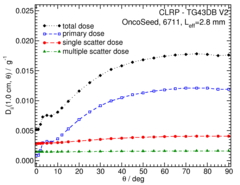
Source Description:
Source dimensions for the 6711 seed are taken from the paper by Dolan et al 1 which presents a more realistic geometry than was used in previous studies. The 6711 source consists of radioactive AgBr and AgI (2.5:1 molecular ratio of AgBr:AgI and a density of 6.2 g/cm3) (Note: the prevoius database took 2.5:1 as the molcular ratio of AgI to AgBr) coated on a 2.8 mm long cylindrical silver rod with a 0.25 mm radius. The ends of the silver rod are conical sections bevelled at 45.0o and the end faces of the rod have a radius of 0.175 mm. The radioactive coating is assumed to have a thickness of 1.75 μm over the entire surface of the rod. The silver rod is encapsulated in a 3.75 mm long titanium tube with 0.07 mm thick walls, a 0.8 mm outer diameter and 0.4 mm thick hemi-spherical end welds (Note: the BrachyDose model of this seed previously used 0.375 mm thick end welds, which caused a small discontinuity between the end welds and the cylindrical capsule). The overall source length is 4.55 mm and the active length is 2.8 mm. The cylindrical source element is free to move 0.835 mm along the seed axis and 0.08 mm radially from the center of the seed, however, we assume the silver rod is always centred. The mean photon energy calculated on the surface of the source is 27.34 keV with statistical uncertainties < 0.01%
Dose-Rate Constant - Λ :
Dose-rate constants, Λ , are calculated by dividing the dose to water per history in a (0.1 mm)3 voxel centered on the reference position, (1 cm,Π/2), in the 30x30x30 cm3 water phantom, by the air-kerma strength per history (scored in vacuo). As described in ref.2, dose-rate constants are provided for air-kerma strength calculated using voxels of 2.66x2.66x0.05 cm3 (WAFAC) and 0.1x0.1x0.05 cm3 (point) located 10 cm from the source. The larger voxel size averages the air-kerma per history over a region covering roughly the same solid angle subtended by the primary collimator of the WAFAC 3,4 at NIST used for calibrating low-energy brachytherapy sources and is likely the most clinically relevant value. The small voxel serves to estimate the air kerma per history at a point on the transverse axis and includes a small 1/r2 correction (0.5%) 2. egs_brachy and BrachyDose uncertainties are only statistical uncertainties (k=1).
| Author | Method | Λ (cGy h-1 U-1) | Abs. Uncertainty |
| Safigholi et al 5 | WAFAC |
0.932
|
0.0004
|
|
Safigholi et al 5
|
Point
|
0.951
|
0.001
|
|
Taylor, Rogers 6
|
WAFAC
|
0.924
|
0.002
|
|
Taylor, Rogers 6
|
Point
|
0.942
|
0.003
|
|
Dolan et al 1
|
extrap/WAFAC (PTRAN)
|
0.942
|
0.017
|
|
Dolan et al 1
|
TLD dosimetry
|
0.971
|
0.059
|
|
Rodriguez, Rogers 7
|
TLD (Revised Dolan)
|
0.915
|
0.057
|
|
Chen and Nath 8
|
Photon Spectrometry
|
0.960
|
0.037
|
|
Rodriguez, Rogers 9
|
WAFAC (BrachyDose)
|
0.928
|
0.002
|
|
Rivard et al 10
|
TG-43U1 Consensus Value
|
0.965
|
---
|
Radial dose function - g(r):
The radial dose function, g(r), is calculated using both line and point source geometry functions and tabulated at 36 different radial distances ranging from 0.05 cm to 10 cm. Fit parameters for a modified polynomial expression are also provided 11. The mean residual deviations from the actual data for the best fit were < 0.031%.
| Fitting coefficients for g L (r) = (a0 r-2 + a1 r-1 + a2 + a3r + a4r2 + a5 r3) e-a6r | |||
| Fit range | Coefficients | ||
| r min (cm) | r max (cm) | ||
| 0.05 | 10.00 | a0 / cm2 | (5.1+/-0.6)E-03 |
| a1 / cm | (-2.91+/-0.28)E-02 | ||
| a2 | (1.166+/-0.005)E+00 | ||
| a3 / cm-1 | (4.44+/-0.06)E-01 | ||
| a4 / cm-2 | (-1.34+/-0.28)E-03 | ||
| a5 / cm-3 | (2.68+/-0.13)E-03 | ||
| a6 / cm-1 | (4.641+/-0.024)E-01 | ||
Anisotropy function - F(r,θ):
Anisotropy functions are calculated using the line source approximation and tabulated at radii of 0.1, 0.15, 0.25, 0.5, 0.75, 1, 2, 3, 4, 5, 7.5 and 10 cm and 32 unique polar angles with a minimum resolution of 5 o . The anisotropy factor, φ an (r), was calculated by integrating the solid angle weighted dose rate over 0 o ≤ ϑ ≤ 90 o .
Primary and Scatter Separated (PSS) Dose Data: Dii(r, Θ):
Primary and Scatter Separated (PSS) dose data are tabulated at 24 radii from 0.1 cm to 10 cm and 24 unique polar angles with a minimum resolution of 5 o . High resolution (Δr = 1 mm, ΔΘ = 1 o ) primary scatter dose data are also available in .csv files. For the purposes of these calculations, scatter within the source is not considered as scatter and any photon escaping the source encapsulation is considered a primary. Only photons which scatter within the phantom are counted in the scatter tallies. Doses are normalized to the total photon energy escaping the encapsulation.
High resolution (1mm/1°) Tabulated D ii (r,θ) data in .csv format: Zipped archive
Click images for higher res versions
Photon Energy Spectra
Photon energy spectra generated by the source model is calculated using egs_brachy surface count scoring option to get the spectrum on the surface of the source. The relative counts is the counts per 0.1 keV bin per MeV normalized to 1 count per MeV-1. The MC calculations have a statistical uncertainty less than 0.0.01% on the mean energy. The spectrum data is available in xmgrace format below.
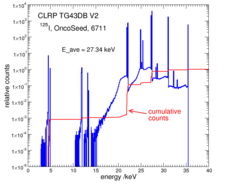
Energy weighted photon spectrum data: xmgrace
Tabulated data:
Tabulated data are available in .xlsx format: Excel
References:
1. J. Dolan et al , Monte Carlo and experimental dosimetry of an 125-I brachytherapy seed, Med. Phys., 33 , 4675 - 4684, 2006.
2. R. E. P. Taylor et al , Benchmarking BrachyDose: voxel-based EGSnrc Monte Carlo calculations of TG--43 dosimetry parameters, Med. Phys., 34 , 445 - 457, 2007.
3. R. Loevinger, Wide-angle free-air chamber for calibration of low--energy brachytherapy sources, Med. Phys., 20 , 907, 1993.
4. S. M Seltzer et al , New National Air-Kerma-Strength Standards for 125I and 103Pd Brachytherapy Seeds, J. Res. Natl. Inst. Stand. Technol., 108 , 337 - 358, 2003.
5. H. Safigholi, M. J. P. Chamberland, R. E. P. Taylor, C. H. Allen, M. P. Martinov, D. W. O. Rogers, and R. M. Thomson, Updated of the CLRP TG-43 parameter database for low-energy photon-emitting brachytherapy sources, to be published (Current calculation).
6. R. E. P. Taylor, D. W. O. Rogers, An EGSnrc Monte Carlo-calculated database of TG-43 parameters, Med. Phys., 35 , 4228-4241,2008. 7. M. Rodriguez and D. W. O. Rogers, Effect of improved TLD dosimetry on the determination of dose rate constants for 125I and 103Pd brachytherapy seeds, Med. Phys., 41, 114301, 2014. 8. Zhe (Jay) Chen and Ravinder Nath, A systematic evaluation of the dose-rate constant determined by photon spectrometry for 21 different models of low-energy photon-emitting brachytherapy sources, Phys. Med. Biol., 55 , 6089, 2010. 9. M. Rodriguez and D. W. O. Rogers, On determining dose rate constants spectroscopically, Med. Phys., 40, 011713, 2013.
10. M. J. Rivard et al , Update of AAPM Task Group No. 43 Report: A revised AAPM protocol for brachytherapy dose calculations, Med. Phys., 31 , 633 - 674, 2004.
11. R. E. P. Taylor, D. W. O. Rogers, More accurate fitting of 125I and 103Pd radial dose functions, Med. Phys., 35 , 4242--4250, 2008.
